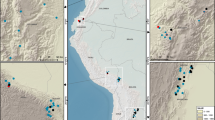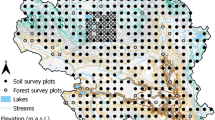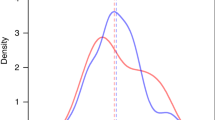Abstract
Increased soil organic matter decomposition with increasing temperature has been hypothesized to enhance soil nitrogen availability, consequently stimulating forest biomass production and offsetting decomposition-induced soil carbon losses1,2,3,4,5. This projection, however, is based on evidence gathered from short-term studies (≤10 years)2,3,5. The key question for carbon sequestration is whether such responses are transient or persist over long forest rotation periods. Here we report on biomass production in a typical nitrogen-limited boreal Picea abies forest, exposed to 18 years of soil warming manipulation (+5 °C) at a plot scale (100 m2). We show that two decades of soil warming elicited only short-duration growth responses, thus not significantly increasing aboveground biomass accumulation. Furthermore, in combination with published work from this forest, our results suggest that increased decomposition is slight and ephemeral, and increased fine root production and turnover in deeper soil may be greater than increased decomposition, netting slightly more biomass, perhaps conserving the soil carbon stock. Thus, this long-term study does not support the notion that the projected increase in soil temperatures will cause either an increased carbon loss with decomposition or a compensatory growth increase from nitrogen mineralization.
This is a preview of subscription content, access via your institution
Access options
Access Nature and 54 other Nature Portfolio journals
Get Nature+, our best-value online-access subscription
$29.99 / 30 days
cancel any time
Subscribe to this journal
Receive 12 print issues and online access
$209.00 per year
only $17.42 per issue
Buy this article
- Purchase on Springer Link
- Instant access to full article PDF
Prices may be subject to local taxes which are calculated during checkout



Similar content being viewed by others
Data availability
The data that support the findings of this study are available from the corresponding authors upon request.
Change history
23 January 2019
In the version of the Supplementary Information file originally published with this Letter, ref. 42 — Andersson, P., Berggren, D. & Nilsson, I. Indices for nitrogen status and nitrate leaching from Norway spruce (Picea abies (L.) Karst.) stands in Sweden. For. Ecol. Manag. 157, 39–53 (2002) — should have appeared as a footnote to Supplementary Table 2; this has now been added.
23 November 2021
A Correction to this paper has been published: https://doi.org/10.1038/s41558-021-01234-z
References
Melillo, J. et al. Global climate change and terrestrial net primary production. Nature363, 234–240 (1993).
Jarvis, P. G. & Linder, S. Constraints to growth of boreal forests. Nature405, 904–905 (2000).
Strömgren, M. & Linder, S. Effects of nutrition and soil warming on stemwood production in a boreal Norway spruce stand. Global Change Biol.8, 1194–1204 (2002).
Melillo, J. et al. Soil warming and carbon-cycle feedbacks to the climate system. Science298, 2173–2176 (2002).
Melillo, J. et al. Soil warming, carbon–nitrogen interactions, and forest carbon budgets. Proc. Natl Acad. Sci. USA108, 9508–9512 (2011).
Jenkinson, D. S. et al. Model estimates of CO2 emissions from soil in response to global warming. Nature351, 304–306 (1991).
Goulden, M. L. et al. Sensitivity of boreal forest carbon balance to soil thaw. Science279, 214–217 (1998).
Bond-Lamberty, B. & Thomson, A. Temperature-associated increases in the global soil respiration record. Nature464, 579–582 (2010).
Dixon, R. K. et al. Carbon pools and flux of global forest ecosystems. Science263, 185–190 (1994).
Schimel, D. S. et al. Recent patterns and mechanisms of carbon exchange by terrestrial ecosystems. Nature414, 169–172 (2001).
Tamm, C. O. Nitrogen in Terrestrial Ecosystems: Questions of Productivity, Vegetational Changes, and Ecosystem Stability Ecological Studies 81 (Springer, Berlin, 1991).
Bergh, J., Linder, S. & Bergström, J. The effect of water and nutrient availability on the productivity of Norway spruce in northern and southern Sweden. For. Ecol. Manage.119, 51–62 (1999).
Savage, K. E. et al. Long-term changes in forest carbon under temperature and nitrogen amendments in a temperate northern hardwood forest. Glob. Change Biol.19, 2389–2400 (2013).
Bradford, M. A. et al. Thermal adaptation of soil microbial respiration to elevated temperature. Ecol. Lett.11, 1316–1327 (2008).
Melillo, J. et al. Long-term pattern and magnitude of soil carbon feedback to the climate system in a warming world. Science358, 101–104 (2017).
Bergh, J. & Linder, S. Effects of soil warming during spring on photosynthetic recovery in boreal Norway spruce stands. Glob. Change Biol.5, 245–253 (1999).
Linder, S. Foliar analysis for detecting and correcting nutrient imbalances in Norway spruce. Ecol. Bull.44, 178–190 (1995).
Högberg, P. Tansley review No. 95 15N natural abundance in soil-plant systems. New Phytol.137, 179–203 (1997).
Strömgren, M. Soil-Surface CO2Flux and Growth in a Boreal Norway Spruce Stand. PhD thesis, Swedish Univ. Agricultural Sciences (2001).
Fröberg, M. et al. Long-term effects of experimental fertilization and soil warming on dissolved organic matter leaching from a spruce forest in Northern Sweden. Geoderma200, 172–179 (2013).
Leppälammi-Kujansuu, J. et al. Effects of long-term temperature and nutrient manipulation on Norway spruce fine roots and mycelia production. Plant Soil366, 287–303 (2013).
Olsson, P., Linder, S., Giesler, R. & Högberg, P. Fertilization of boreal forest reduces both autotrophic and heterotrophic soil respiration. Glob. Change Biol.11, 1745–1753 (2005).
Majdi, H. & Öhrvik, J. Interactive effects of soil warming and fertilization on root production, mortality, and longevity in a Norway spruce stand in Northern Sweden. Glob. Change Biol.10, 182–188 (2004).
Coucheney, E., Strömgren, M., Lerch, T. Z. & Herrmann, A. M. Long-term fertilization of a boreal Norway spruce forest increases the temperature sensitivity of soil organic carbon mineralization. Ecol. Evol.3, 5177–5188 (2013).
Leppälammi-Kujansuu, J., Salemaa, M., Kleja, D. B. & Linder, S. Fine root turnover and litter production of Norway spruce in a long-term temperature and nutrient manipulation experiment. Plant Soil374, 73–88 (2014).
Persson, H. in Nutrient Cycling in Terrestrial Ecosystems (eds Harrison, A. F., Ineson, P. & Heal, O. W.) 198–217 (Elsevier Applied Science, Barking, 1990).
Carey, J. C. et al. Temperature response of soil respiration largely unaltered with experimental warming. Proc. Natl Acad. Sci. USA113, 13797–13802 (2016).
Oren, R. et al. Soil fertility limits carbon sequestration by forest ecosystems in a CO2-enriched atmosphere. Nature411, 469–472 (2001).
Sigurdsson, B. D., Medhurst, J., Wallin, G., Eggertsson, O. & Linder, S. Growth of mature boreal Norway spruce was not affected by elevated [CO2] and/or air temperature unless nutrient availability was improved. Tree Physiol.33, 1192–1205 (2013).
Hägglund, B. & Lundmark, J.-E. Site index estimation by means of site properties of Scots pine and Norway spruce in Sweden. Stud. For. Suec.138, 1–33 (1977).
Sjörs, H. The background: geology, climate and zonation. Acta Phytogeogr. Suec.84, 5–14 (1999).
Lim, H. et al. Inter-annual variability of precipitation constrains the production response of boreal Pinus sylvestris to nitrogen fertilization. For. Ecol. Manage.348, 31–45 (2015).
Petersson, H. & Ståhl, G. Functions for below-ground biomass of Pinus sylvestris, Picea abies, Betula pendula and Betula pubescens in Sweden. Scand. J. For. Res.21, 84–93 (2006).
Lim, H. et al. Annual climate variation modifies nitrogen induced carbon accumulation of Pinus sylvestris forests. Ecol. Appl.27, 1838–1851 (2017).
Thomas, C. T. & Martin, A. R. Carbon content of tree tissues: a synthesis. Forests3, 332–352 (2012).
Flower-Ellis, J. G. K. Dry-matter allocation in Norway spruce branches: a demographic approach. Stud. For. Suec.191, 51–73 (1993).
Ohlsson, K. E. A. & Wallmark, P. H. Novel calibration with correction for drift and non-linear response for continuous flow isotope ratio mass spectrometry applied to the determination of δ15N, total nitrogen, δ13C and total carbon in biological material. Analyst124, 571–577 (1999).
Reineke, L. H. Perfecting a stand-density index for even-aged forests. J. Agric. Res.46, 627–638 (1933).
Binkley, D., Stape, J. L., Bauerle, W. L. & Ryan, M. G. Explaining growth of individual trees: light interception and efficiency of light use by Eucalyptus at four sites in Brazil. For. Ecol. Manage.259, 1704–1713 (2010).
Pommerening, A. & Muszta, A. Relative plant growth revisited: towards a mathematical standardisation of separate approaches. Ecol. Model.320, 383–392 (2016).
Waring, R. H. Estimating forest growth and efficiency in relation to canopy leaf-area. Adv. Ecol. Res.13, 327–354 (1983).
Acknowledgements
This study received support from the Swedish Foundation for Strategic Environmental Research (MISTRA), the Swedish Governmental Agency for Innovation Systems (VINNOVA), The Swedish Council of Forestry and Agricultural Sciences and Spatial Planning (FORMAS) and the Knut and Alice Wallenberg Foundation (no. 2015.0047). Financial support for R.O. was provided by the Erkko Visiting Professor Programme, through the University of Helsinki. We especially thank Svartberget Field Station for providing staff for fieldwork.
Author information
Authors and Affiliations
Contributions
S.L. established the experiment in 1994, and designed the present study together with H.L, T.N. and R.O. H.G. collected and analysed the water from the lysimeters. H.L. performed all of the final fieldwork. H.L. and R.O. processed the data, crafted the argument and wrote the paper with input from T.N., S.L., M.S. and T.L. All authors discussed the results and commented on the manuscript at all stages.
Corresponding authors
Ethics declarations
Competing interests
The authors declare no competing interests.
Additional information
Publisher’s note: Springer Nature remains neutral with regard to jurisdictional claims in published maps and institutional affiliations.
Supplementary information
Supplementary Information
Supplementary Tables 1–3, Supplementary Figures 1–2
Rights and permissions
About this article
Cite this article
Lim, H., Oren, R., Näsholm, T. et al. Boreal forest biomass accumulation is not increased by two decades of soil warming. Nat. Clim. Chang. 9, 49–52 (2019). https://doi.org/10.1038/s41558-018-0373-9
Received:
Accepted:
Published:
Issue Date:
DOI: https://doi.org/10.1038/s41558-018-0373-9
This article is cited by
-
Responses of soil organic carbon to climate extremes under warming across global biomes
Nature Climate Change (2024)
-
Reassessment of growth-climate relations indicates the potential for decline across Eurasian boreal larch forests
Nature Communications (2023)
-
Shortened Fire Intervals Stimulate Carbon Losses from Heterotrophic Respiration and Reduce Understorey Plant Productivity in Boreal Forests
Ecosystems (2023)
-
Increased tree growth following long-term optimised fertiliser application indirectly alters soil properties in a boreal forest
European Journal of Forest Research (2021)
-
Nonadditive and Legacy Effects of Spring and Autumn Warming on Soil Respiration in an Old-Field Grassland
Ecosystems (2021)



